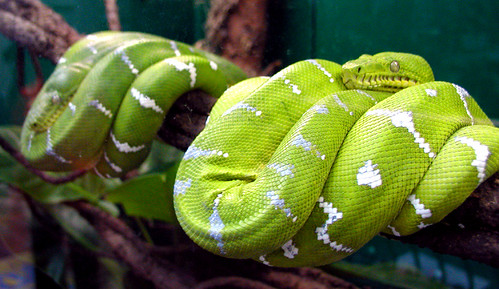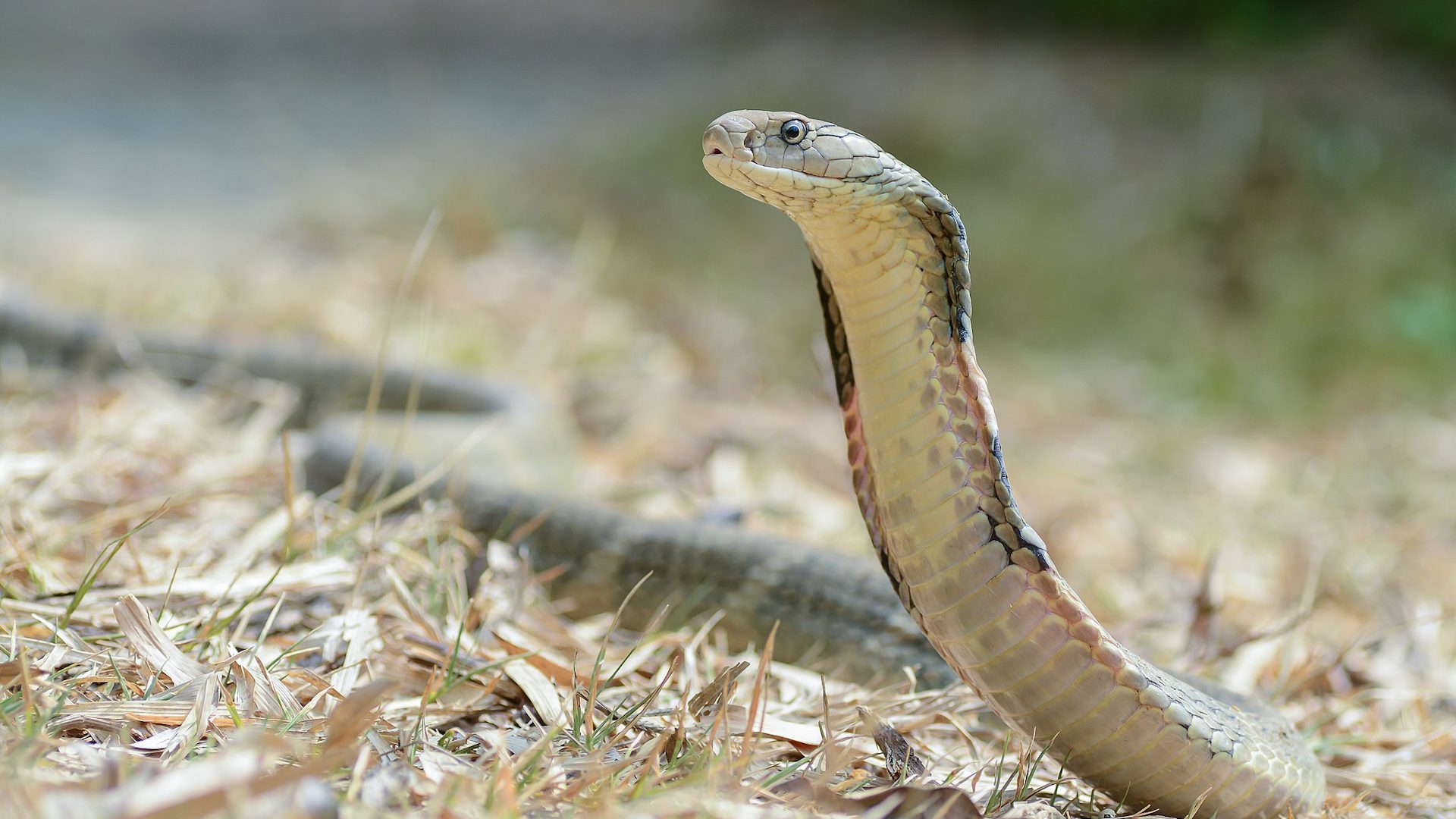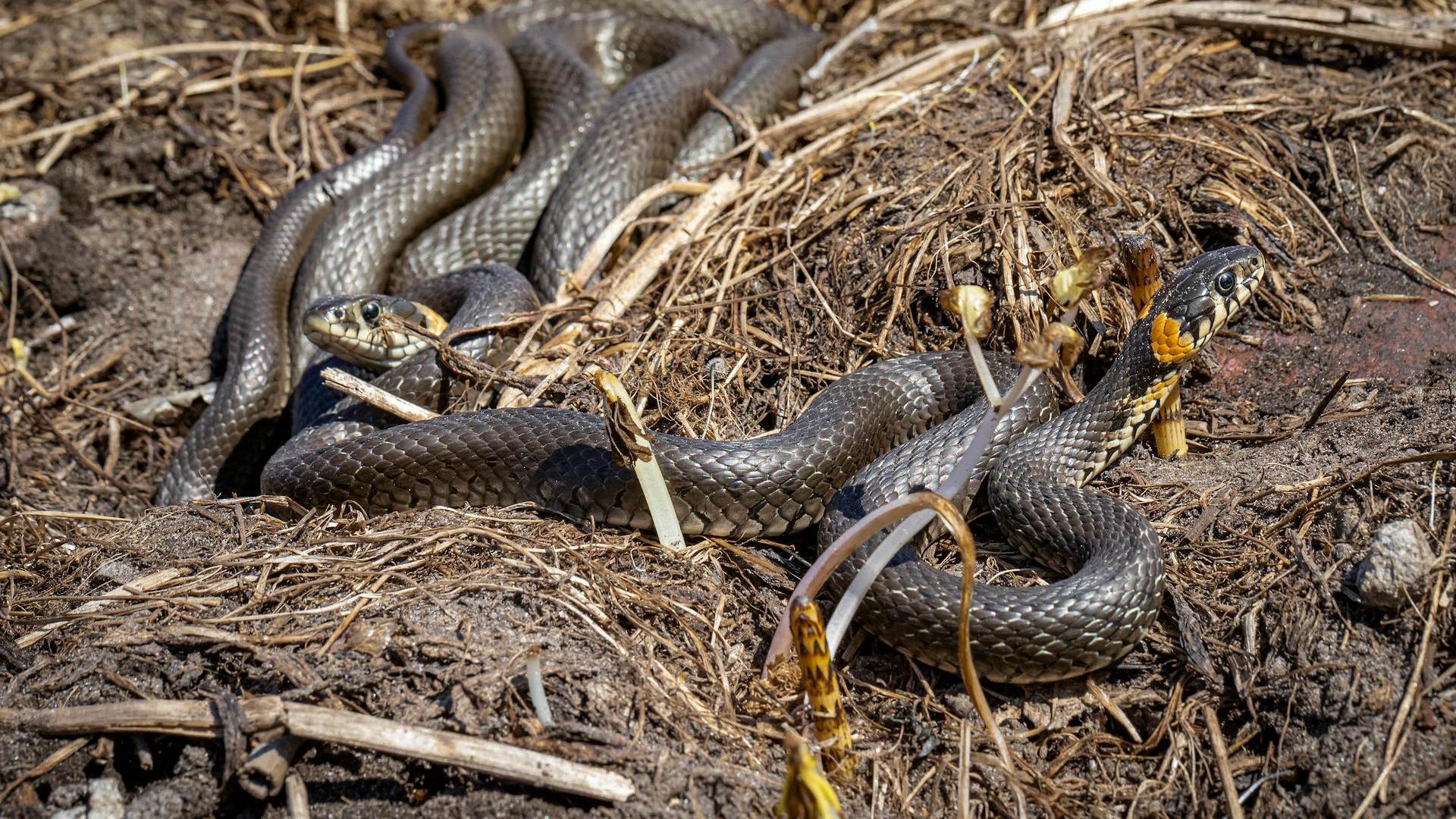Venomous snakes are often associated with danger and fear, but many species possess stunning colors and patterns that rival the most beautiful creatures on Earth. These vibrant hues aren’t merely for show—they often serve as warning signals to potential predators, a biological phenomenon known as aposematism. From the azure blues of sea snakes to the brilliant reds of coral snakes, these deadly reptiles demonstrate nature’s paradoxical ability to combine deadly venom with breathtaking beauty. Join us as we explore some of the most visually spectacular venomous snakes found across the globe, examining not only their striking appearances but also their fascinating biology, habitats, and the important ecological roles they play.
Blue Malayan Coral Snake (Calliophis bivirgatus)
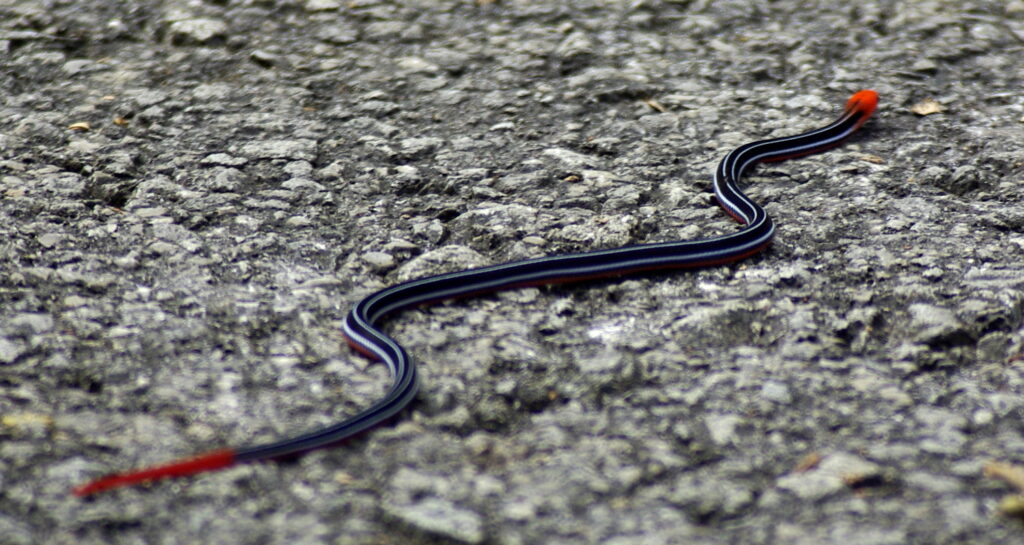
The Blue Malayan Coral Snake possesses one of the most striking color combinations in the snake world, with a vivid electric-blue dorsal stripe running along its body, complemented by a bright red head and tail. This medium-sized elapid, native to Southeast Asian rainforests, grows to approximately 1.4 meters (4.6 feet) in length and spends most of its time beneath forest leaf litter. Its specialized venom glands are extraordinarily long, extending for about one-quarter of the snake’s body length, producing a potent neurotoxin that primarily targets other snakes, which make up the bulk of its diet. Despite its incredible beauty, the Blue Malayan Coral Snake is seldom seen by humans due to its secretive, fossorial habits and preference for undisturbed forest habitats.
Banded Sea Krait (Laticauda colubrina)
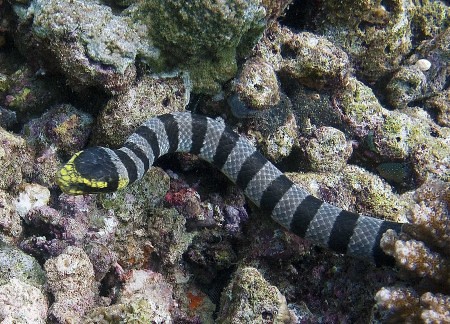
The Banded Sea Krait features a striking pattern of alternating black and blue-gray bands that encircle its entire body, creating a distinctive and beautiful appearance in its marine environment. This amphibious sea snake spends roughly half its life on land and half in water, coming ashore to rest, digest, lay eggs, and shed its skin on islands throughout the Indo-Pacific region. Despite possessing venom estimated to be 10 times more potent than that of a cobra, Banded Sea Kraits are surprisingly docile and rarely bite humans, preferring to flee rather than confront potential threats. Their specialized paddle-shaped tail and valved nostrils allow them to move gracefully through water while hunting for moray eels and small fish, which they immobilize with their powerful neurotoxic venom.
Eastern Coral Snake (Micrurus fulvius)
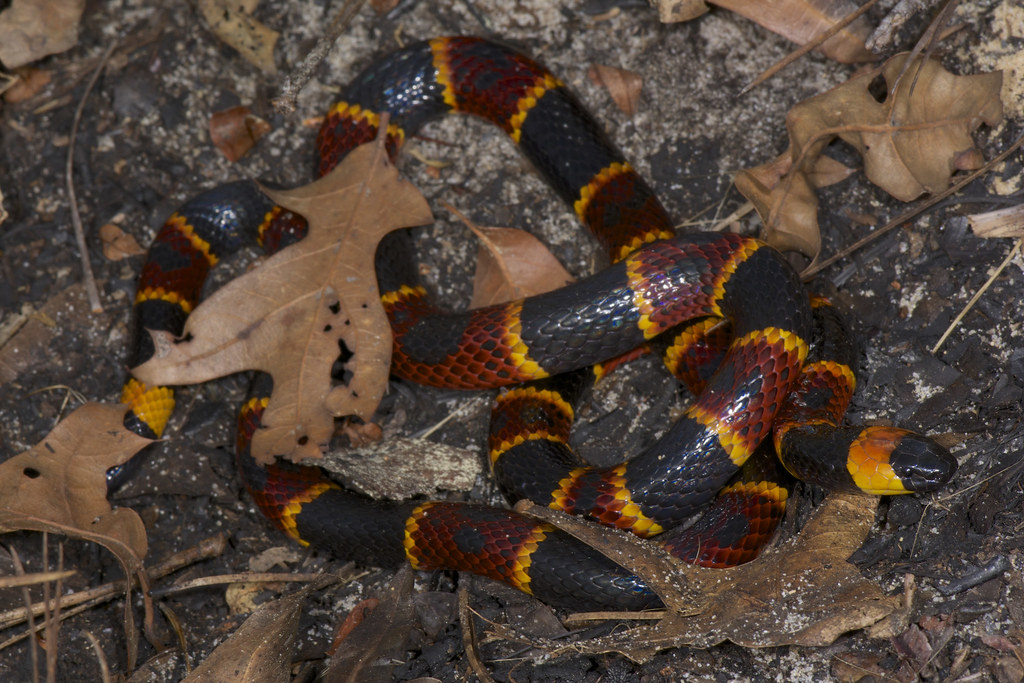
The Eastern Coral Snake displays the classic red, yellow, and black banding pattern that has inspired the famous rhyme “red touch yellow, kill a fellow,” serving as a warning to potential predators about its deadly venom. Native to the southeastern United States, this relatively small elapid typically grows to between 60-100 cm (24-39 inches) in length and possesses some of the most potent venom of any North American snake, containing powerful neurotoxins that can cause respiratory failure. Despite its toxicity, the Eastern Coral Snake is remarkably shy and reclusive, spending most of its time burrowed beneath forest floor debris or inside rotting logs, and it accounts for less than 1% of venomous snakebites in the United States annually. The vibrant coloration serves as a perfect example of aposematism, with several non-venomous species like the Scarlet Kingsnake evolving to mimic its distinctive pattern—a phenomenon known as Batesian mimicry.
Blue-Lipped Sea Krait (Laticauda laticaudata)
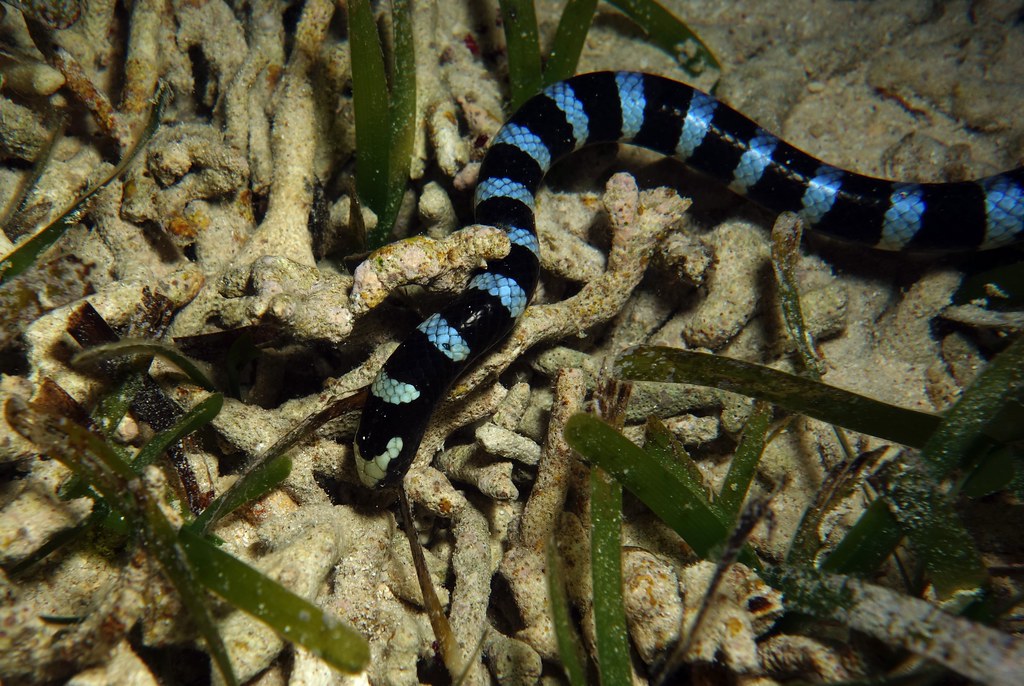
The Blue-Lipped Sea Krait features a stunning combination of a bluish-gray body with distinctive black bands and, most notably, vibrant blue lips that make it instantly recognizable among sea snakes. This highly venomous elapid inhabits coral reefs and coastal areas throughout the Indian and Western Pacific Oceans, where it hunts primarily at night for small fish and eels that hide in reef crevices. Like its relatives, the Blue-Lipped Sea Krait is amphibious, regularly coming ashore to rest, digest meals, and lay eggs, though it can remain underwater for up to eight hours thanks to specialized adaptations in its lungs that allow efficient oxygen extraction. Despite producing a potent neurotoxic venom, these beautiful snakes rarely bite humans and are generally considered non-aggressive unless severely provoked or handled.
Red-Headed Krait (Bungarus flaviceps)
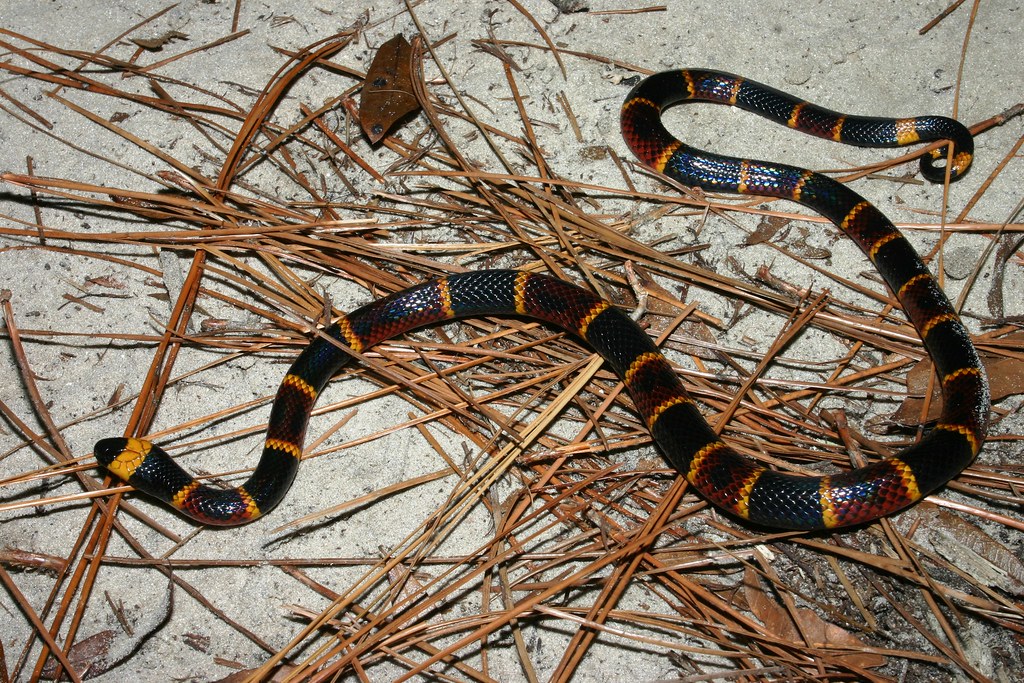
The Red-Headed Krait showcases a dramatic color contrast with its bright red or orange head and tail set against a glossy black body, creating one of the most visually striking appearances among venomous snakes. Native to the rainforests of Southeast Asia, this elusive elapid grows to approximately 2 meters (6.5 feet) in length and possesses highly potent neurotoxic venom that it uses primarily to hunt other snakes, including venomous species. The Red-Headed Krait is primarily nocturnal, spending daylight hours concealed beneath forest debris or in burrows, and despite its deadly venom, it rarely encounters humans due to its preference for undisturbed forest habitats. Interestingly, the vibrant red coloration fades somewhat in adult specimens, with juveniles displaying the most intense hues—a characteristic that has fascinated herpetologists studying color development in venomous snakes.
Variable Coralsnake (Micrurus diastema)

The Variable Coralsnake lives up to its name with remarkable diversity in its color patterns across its range, displaying various arrangements of red, yellow, and black bands that can differ significantly between regions and even individual specimens. This medium-sized venomous snake is native to southern Mexico and Central America, where it inhabits tropical forests and spends much of its time beneath leaf litter or burrowing through loose soil. Like other coral snakes, it possesses a potent neurotoxic venom and specialized short, fixed fangs at the front of its mouth that it uses primarily for subduing its preferred prey of smaller snakes and lizards. The Variable Coralsnake’s incredible color diversity has made it a subject of interest for scientists studying the evolution and genetics of warning coloration, as different populations have developed distinct patterns while maintaining the recognizable tricolor banding that serves as a warning to potential predators.
Yellow-Bellied Sea Snake (Hydrophis platurus)
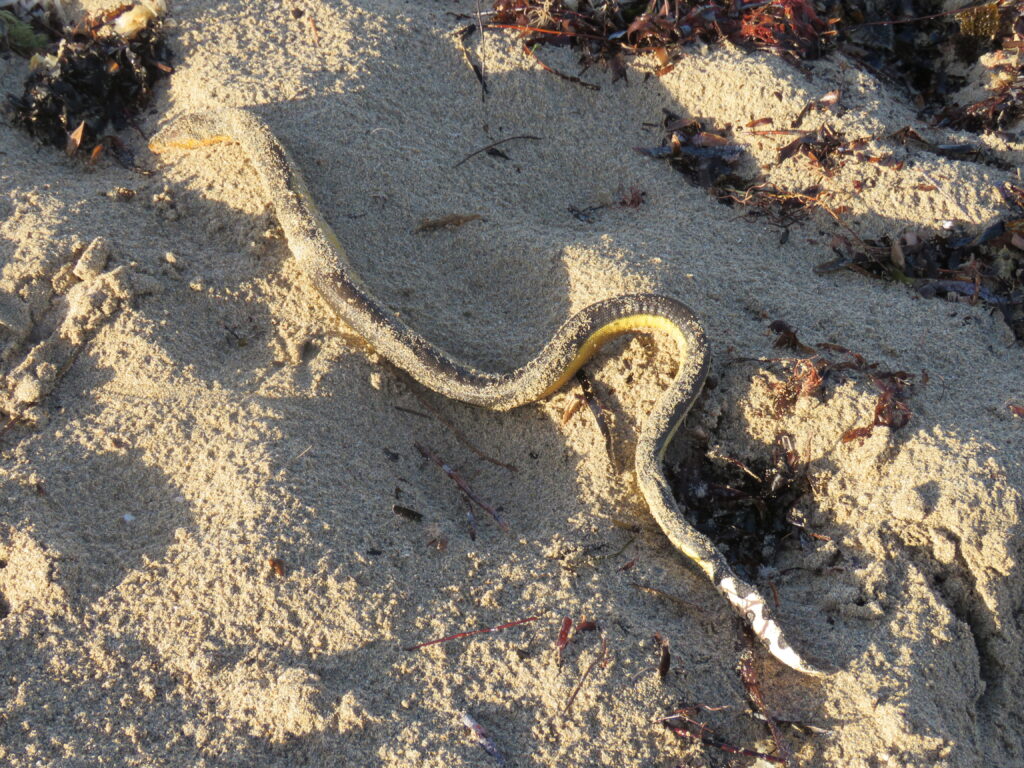
The Yellow-Bellied Sea Snake features a strikingly simple yet effective color pattern with a glossy black or dark brown upper body sharply contrasted against a vibrant yellow or yellow-cream underbelly, creating a two-toned appearance perfectly suited to its oceanic lifestyle. This highly specialized marine reptile has the distinction of being the most widely distributed snake species in the world, found throughout tropical and subtropical waters of the Indian and Pacific Oceans, and is the only truly pelagic sea snake, spending its entire life in open ocean waters. Its distinctive coloration provides perfect camouflage in its marine environment—when viewed from below, the yellow underside blends with sunlight penetrating the water’s surface, while the dark upper body disappears against the depths when viewed from above. Despite possessing highly potent neurotoxic venom, the Yellow-Bellied Sea Snake rarely poses a threat to humans due to its docile nature and specialized jaw structure that makes it difficult to bite anything larger than its normal fish prey.
San Francisco Garter Snake (Thamnophis sirtalis tetrataenia)
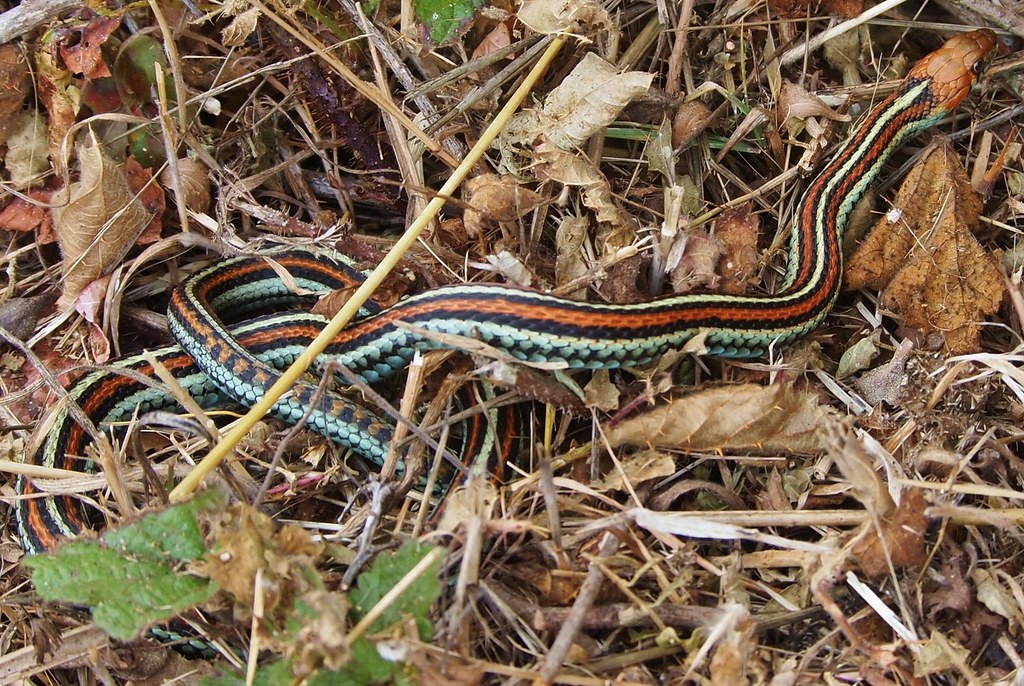
The San Francisco Garter Snake is often considered the most beautiful serpent in North America, displaying a stunning arrangement of red, black, and turquoise-blue stripes running the length of its slender body. This endangered subspecies of the Common Garter Snake is endemic to a small region of the San Francisco Peninsula in California, where it inhabits wetlands, marshy areas, and grasslands adjacent to ponds and streams. While garter snakes produce a mild venom that affects their amphibian and fish prey, it’s generally harmless to humans and technically classifies them as venomous, though they’re often mistakenly categorized as non-venomous due to the minimal effect their toxin has on larger animals. The San Francisco Garter Snake’s remarkable coloration has unfortunately contributed to its endangered status, as its beauty has made it a target for illegal collection for the pet trade, compounding the severe habitat loss that remains its primary threat.
Blue Coral Snake (Calliophis bivirgata)
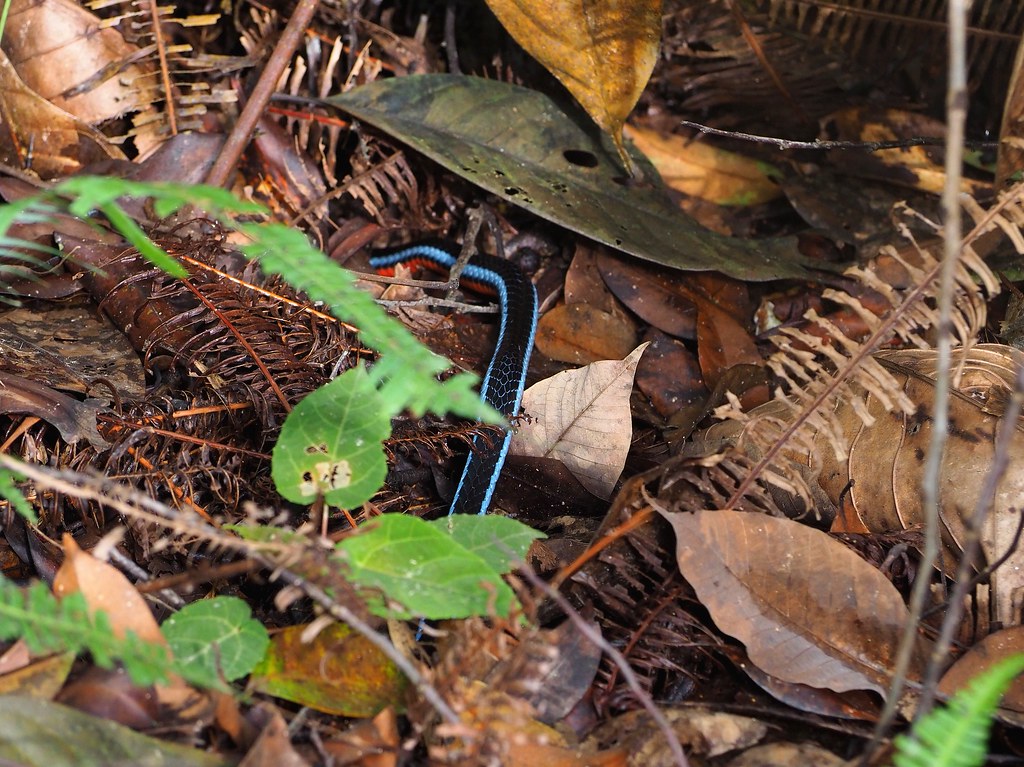
The Blue Coral Snake exhibits an extraordinary electric-blue dorsal coloration that seems almost artificial in its intensity, complemented by a bright red tail and head that create a color combination unmatched in the snake world. Native to Southeast Asian rainforests, this elusive elapid has evolved specialized venom glands that extend for up to one-third of its body length—the longest of any snake species—producing a powerful neurotoxin primarily used for hunting other snakes. Despite its breathtaking appearance and deadly venom, the Blue Coral Snake is rarely seen by humans due to its secretive nature and preference for undisturbed forest habitats where it spends much of its time burrowing through soil and leaf litter. Its vibrant coloration serves as a perfect example of aposematism—a warning advertisement to potential predators about its dangerous nature—and researchers believe the intensity of its blue pigmentation may have evolved specifically to be visible in the low-light conditions of the forest floor.
Rhinoceros Viper (Bitis nasicornis)
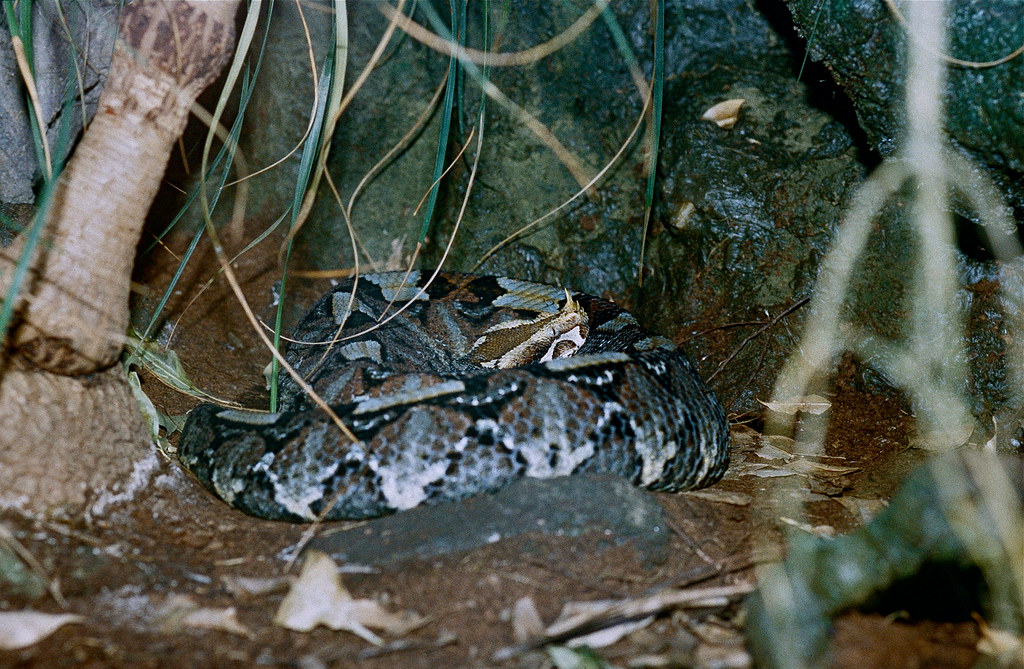
The Rhinoceros Viper possesses perhaps the most elaborately patterned scales of any venomous snake, with a kaleidoscopic arrangement of blue, purple, green, red, black, and yellow geometric patterns adorning its heavy body. Named for the distinctive upturned scales on its snout that resemble horns, this ambush predator inhabits the rainforests and swamps of Central and Western Africa, where its intricate pattern provides perfect camouflage among the colorful forest floor vegetation. Unlike many colorful venomous snakes that are relatively slender, the Rhinoceros Viper has a thick, heavy body that can exceed 1 meter (3.3 feet) in length and possesses large, hinged fangs that deliver a hemotoxic venom causing severe tissue damage and bleeding. Despite its relatively sluggish nature, the Rhinoceros Viper can strike with remarkable speed when threatened or hunting, though it generally relies on its extraordinary camouflage to avoid detection by both predators and prey.
Mangrove Snake (Boiga dendrophila)
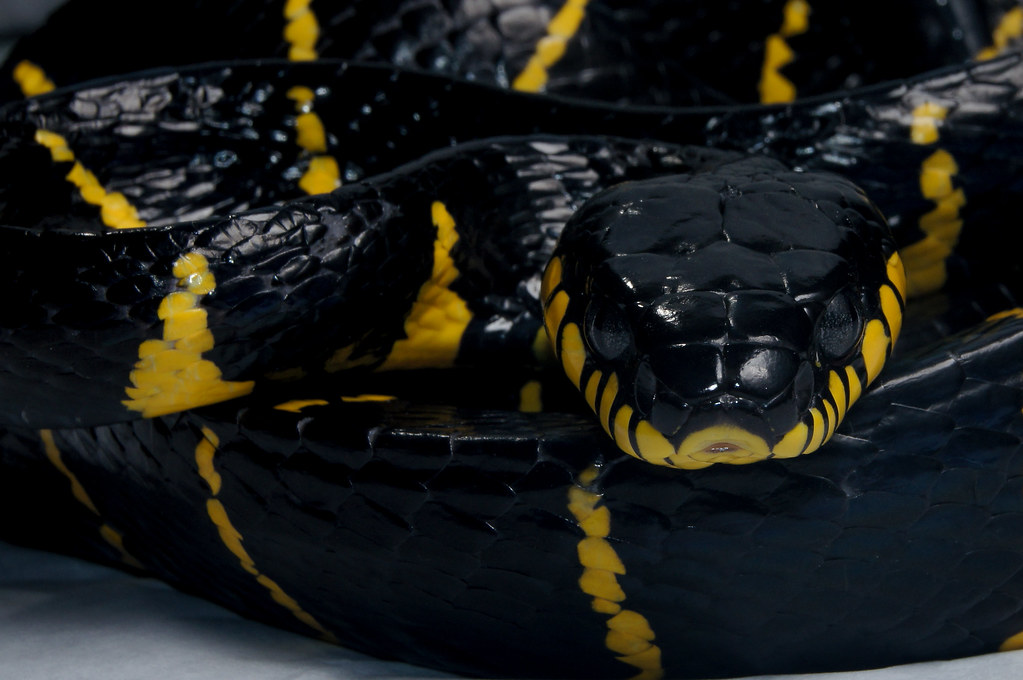
The Mangrove Snake displays a glossy black body adorned with vibrant yellow bands that completely encircle its slender frame, creating a striking contrast that’s particularly visible as it moves through its arboreal habitat. Native to Southeast Asian mangrove forests and nearby wooded areas, this rear-fanged colubrid grows to approximately 2 meters (6.5 feet) in length and spends much of its time in trees, where it hunts birds, lizards, and small mammals under the cover of darkness. While classified as venomous, the Mangrove Snake is rear-fanged (opisthoglyphous) with a relatively mild venom that’s primarily effective on its small prey and poses minimal risk to humans beyond localized swelling and discomfort. The snake’s dramatic black and yellow coloration serves as an excellent example of aposematism in a mildly venomous species, providing protection from predators that might have learned to avoid similarly colored, but more dangerous, snakes in the region.
Bush Viper (Atheris squamigera)
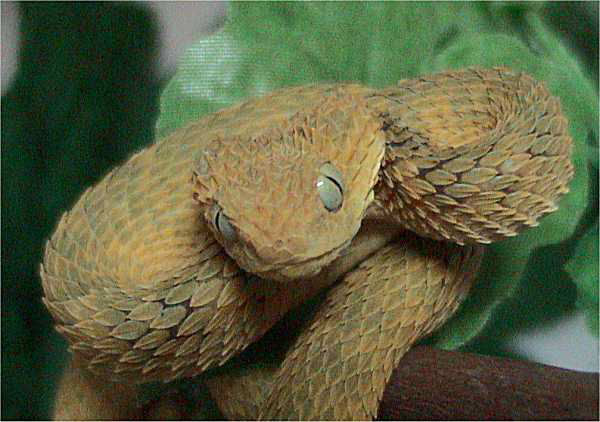
The Bush Viper showcases an extraordinary range of color variations, appearing in stunning shades of green, yellow, orange, and even blue, with keeled scales that give it a distinctly rough, almost dragon-like appearance. This arboreal viper inhabits the rainforests of Central and Western Africa, where its relatively small size of 46-60 cm (18-24 inches) and prehensile tail make it perfectly adapted for life among the branches and vines of its forest home. Bush Vipers possess hemotoxic venom delivered through long, hinged fangs that fold against the roof of the mouth when not in use, and while not typically lethal to humans, their bite can cause severe pain, swelling, and bleeding that requires immediate medical attention. The remarkable diversity of color morphs within this species has made it particularly sought after in the exotic pet trade, unfortunately leading to population declines in some regions despite the significant danger they pose as captives due to their nervous temperament and potentially serious venom.
Conclusion
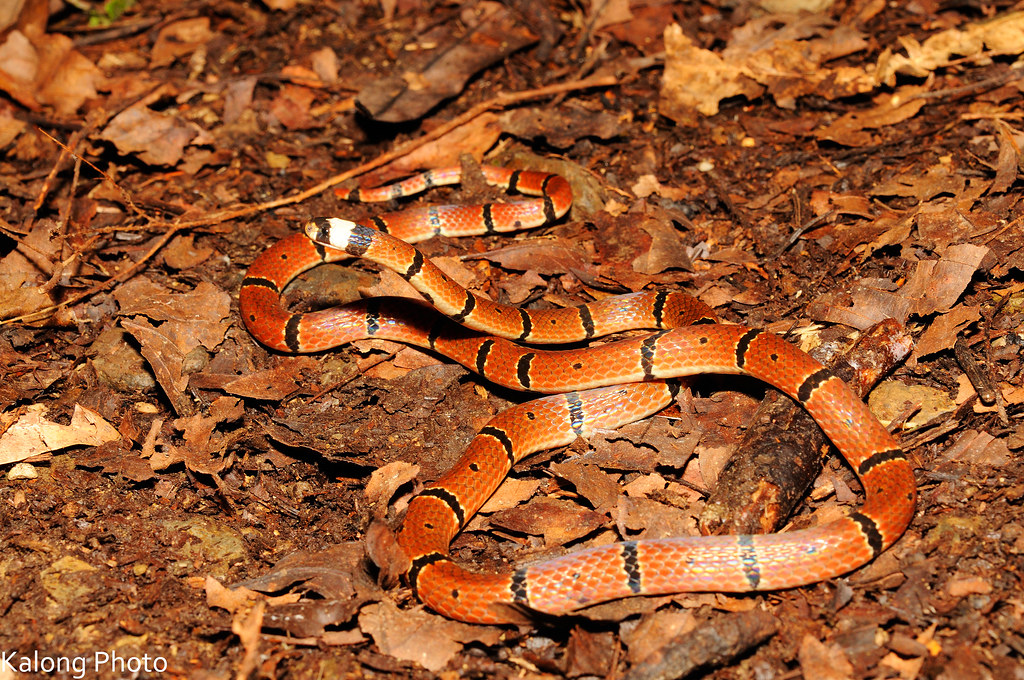
From the electric blue of coral snakes to the mesmerizing patterns of vipers, these colorful venomous serpents remind us that nature often packages danger in the most beautiful wrappings. While their vibrant scales may attract our attention, they deserve our respect from a safe distance. These spectacular species play crucial roles in their ecosystems as both predators and prey, and many face threats from habitat loss and human encroachment. Understanding and appreciating these magnificent creatures—their colors, behaviors, and ecological importance—is key to ensuring their survival for generations to come.

